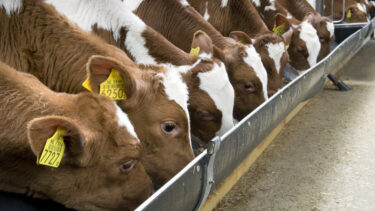GUT HEALTH AND PULMONARY PROBLEMS: an interconnected problem
By Wim Wanzele (Nutrition and Farm Managment specialist)
Intestinal and respiratory problems are considered major threats because they are responsible for the majority of calves’ mortality and morbidity. In addition, a healthy and properly functioning rumen is crucial for calf growth and later production. In order to raise healthy, well-producing, and long-living cattle, the focus should be on these topics right from the start.
threat nr. 1: CALF SCOURS
With several causes, calf scours are the main cause of mortality and morbidity during the first 5 weeks of life. The primary causes are bad colostrum management, incorrect (milk) feeding practices, and the use of a poor-quality milk replacer and/or calf starter.
threat nr. 2: Respiratory diseases
Respiratory problems typically occur from 5 to 25 weeks of age. Bovine Respiratory Disease (BRD) causes high mortality and morbidity in the calf rearing phase. Since BRD causes long-lasting negative effects by irreversibly damaging the lungs, infection results in reduced growth and leads to lower performance later in life.
Though it seems these two threats do not have much in common, it is becoming increasingly evident that intestinal disorders can have pulmonary manifestations and vice versa. This is because these two regions are interconnected via the so-called “gut-lung axis” (Figure 1).

The gastrointestinal tract and lungs communicate with each other at certain levels. For example, if an intestinal disorder causes damage to the gut barrier, this results in bacteria (endotoxins and inflammatory cytokines) entering the blood circulation. Via this route, these detrimental molecules can reach the lungs and eventually cause damage there.
Many studies suggest the important role of the gut-lung axis in calves and highlight the need for intestinal barrier integrity and gut health. Calves suffering from intestinal problems in early life will be more susceptible to pulmonary infections later. Therefore, it is extremely important to focus on gut health, which is largely determined by the quality of feed given to calves.
Milk feeding: focus on protein digestibility
The focus of a good calf milk replacer (CMR) should be protein quality. Premium quality protein is digested more easily by the calves and thus lowers the risk for digestive disorders. In general, dairy protein sources are highly digestible, so large quantities can be used in calf milk replacers. In contrast, vegetal protein sources are less digestible and sources, like soybean flour, should be limited in calf milk replacers.
Solid feed: focus on rumen development
Next, good quality concentrates, fibers, and water are required to develop a healthy rumen. First, the quality of the starter concentrate will determine the age at which the calf starts consuming solid feed. In this case, the earlier the better as more intake means additional growth. The pre-weaned calf mostly relies on nutrients in milk. A higher milk intake results in higher growth rates before weaning, but implies a lower concentrate intake. So it is crucial to find a good balance between milk and solid feed intake.
The amount and the composition of the calf starter consumed before weaning affects the digestion of solid feed after weaning. Research has shown that non-fiber carbohydrate (NFC) intake impacts the development of the calf’s digestive system. In fact, about 15 kg of cumulative NFC intake is needed for proper rumen development and for the digestive system to fully adapt to solid feed (Quigley et al.,2018). As a consequence, everything that reduces total NFC intake reduces solid feed digestion in early life as this results in less energy and protein availability and, consequently, leads to a slower growth rate.
NFC intake might be limited due to high fiber feeds, forage feeding, or high milk intake. With a very palatable starter containing the right NFC content, it is possible to reach optimal rumen development at 6 weeks of age. From this point, calves can be gradually weaned by reducing milk supply. Slowly reducing milk helps avoid stress-orientated problems and protects against a decline in growth rate. An automatic calf feeder can be helpful in managing this weaning process.
Finally, protein nutrition has an impact on the calf’s development, especially when focusing on gut health and diarrhea prevention. Too much (undigested) protein will result in bacterial protein fermentation and pathogen overgrowth. Remember that “bad” bacteria (E. coli, Clostridium, etc.) are known as dominant protein fermenters. By limiting total protein intake and choosing easily digestible protein sources, the amount of undigested protein in the gut can be restricted. Limiting protein content in calf starters also enables you to incorporate more NFC. In a calf starter, a protein content of 160 g/kg appears to ensure proper rumen development and fast growth after weaning. Another advantage of a lower protein feed is that it can be provided ad libitum without any risk of intestinal health issues until the age of 6 months, resulting in very fast growth.
In conclusion, good nutrition goes beyond gut health and can benefit the overall immune system, helping calves to deal with numerous diseases.
This contact was suggested based on the location you are browsing from. You can of course also consult our other contacts and locations here.

